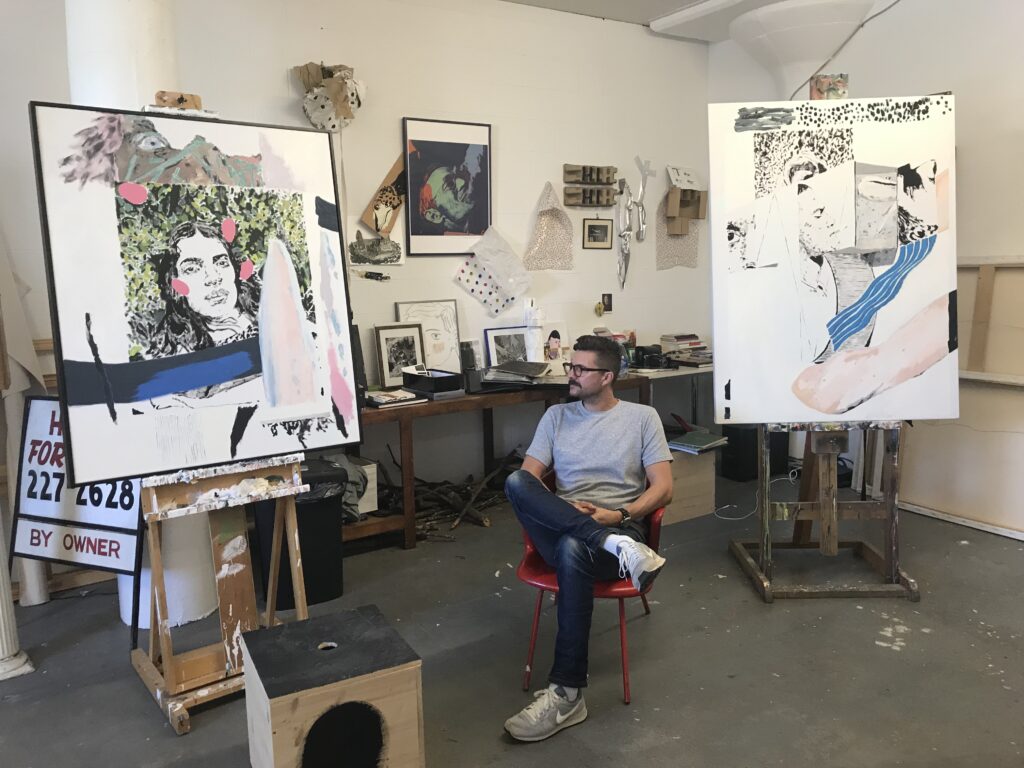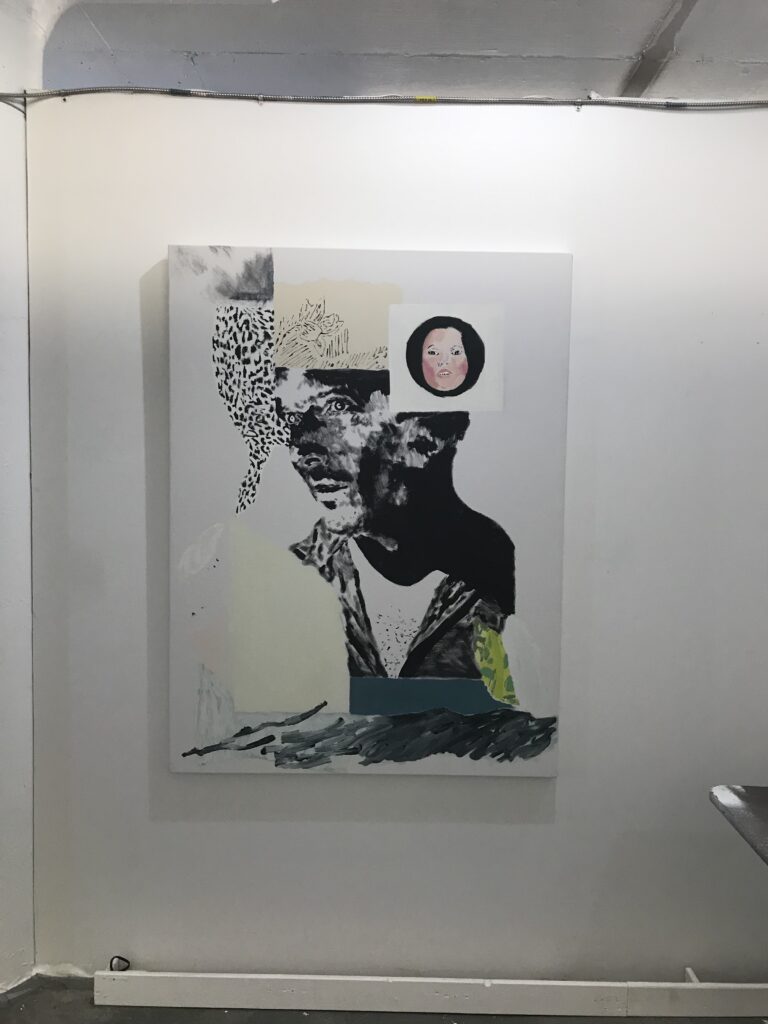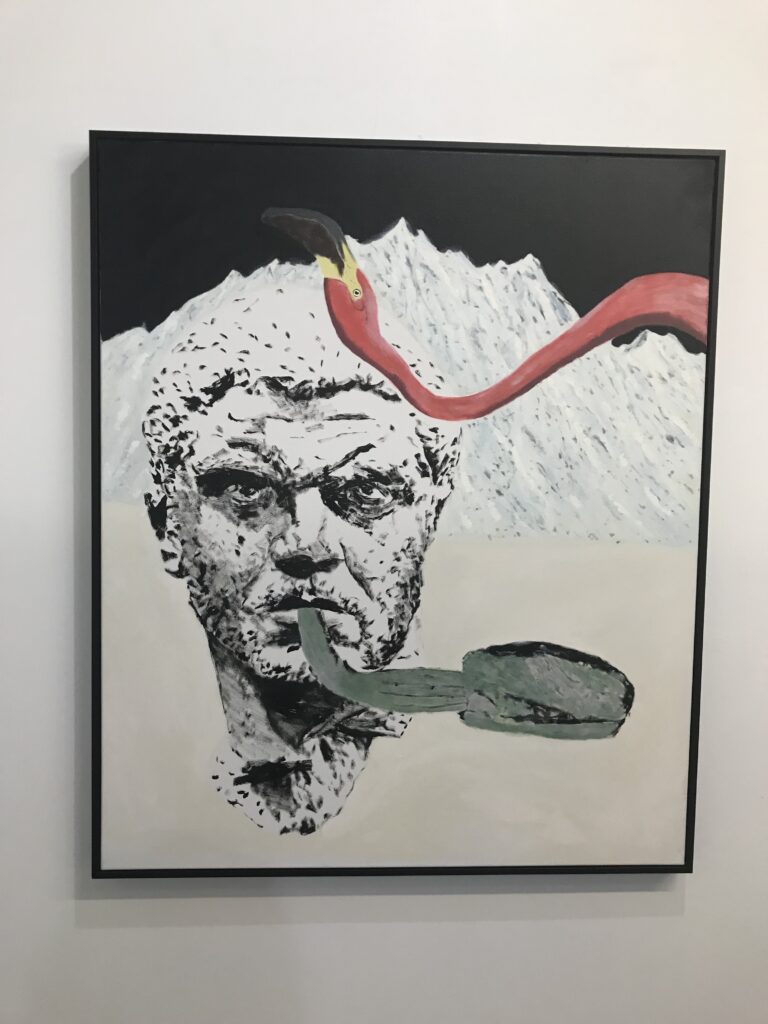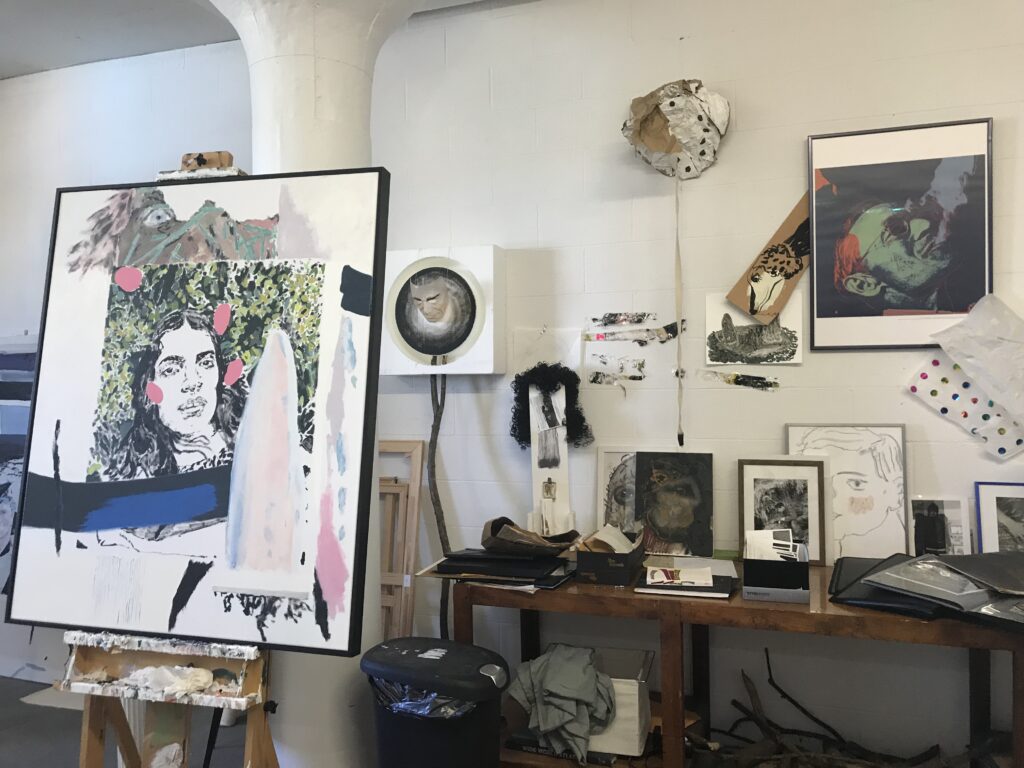When visiting John Brooks’s studio on Lytle Street, one must pass through several rooms before arriving at the inner sanctum of Brooks’s creative practice. First, one enters the ground floor of the Lytle Street building, an industrial warehouse in the Portland neighborhood of Louisville. Then, up the stairs to the second floor, one finds a cluster of different studio spaces occupied by the loose collective of artists who, like Brooks, occupy Lytle Street, among them Letitia Quesenberry, Chris Radtke, Denise Furnish, Dominic Guarnaschelli, Rosalie Rosenthal, and Jacob Heustis. Through a foyer of second-hand furniture and down the hall, there is a door to the first location of Quappi Projects.
Brooks founded this gallery in 2017 with the aim of furthering the artistic conversation amongst artists and art-lovers in Louisville. Named after the affectionate nickname of painter Max Beckmann’s second wife Quappi (a derivation of Kaulquappe, German for “tadpole”), Quappi Projects hosted numerous exhibitions at Lytle Street before moving during the summer of 2019 to its current space on Market Street. Brooks now operates Quappi Projects out of Market Street and continues his studio practice on Lytle. There, tucked within the bright, white-walled space of the former Quappi Projects, one finds a curtain. And behind that curtain is Brooks’s studio: an enclave for his paintings, collages, easels, and gathered sources of inspiration.

As an artist Brooks is at home with the unknown, the ambiguous, the subtle, and the fleeting. His education had various chapters, from studying politics at the University at Charleston, to studying art at the Central St. Martins College of Art & Design and the Hampstead School of Art while living in London, England. The most lasting conceptual impact, however, came from his time spent visiting Berlin over the years and a summer spent studying under the figurative painter Norbert Bisky in 2015 at Berlin’s AUTOCENTER Summer Academy. Brooks’s admiration for Germanic artistic influences and Germany’s sensitivity to its own dark history finds its way into many aspects of his practice. He often returns to the Max Beckmann quote: “All important things in art have always originated from the deepest feeling about the mystery of Being.” He explains, “I came across that quote some years ago and it stuck with me because that is how I look at the world. We understand a lot, but there is also so much that we don’t understand. Or can’t comprehend…I aim to imbue my work with that sense of unknowing. My creative impulses come from that place, and from a place of longing or missing. There’s a great German word for this feeling: Sehnsucht.”
Brooks’s promotion of expansive thinking connects to his work in curation (as the director of Quappi Projects he steers the gallery’s exhibition program), and to his interest in poetry. He describes himself as “a person who writes constantly in my head as I move throughout the day.” Though it felt natural for him to eventually connect his painting to his poetry practice, the result was nonetheless transformative. The titles for his most recent body of paintings are all drawn from his poetry. His series of work, “A Map of Scents,” on view at Moremen Gallery during the summer of 2019, employs this strategy of poetically titling his pictures, as well as a fresh aesthetic that Brooks explains came from integrating his process of collage-making into his painting. Brooks previously felt he could create more freely in the medium of collage, without the historical weight of painting upon him. He had a breakthrough moment when he realized he could combine his collage and painting techniques: “After nearly a decade of almost exclusively creating expressive faces, my painting practice had reached a standstill. I did not see a way forward until it occurred to me to utilize my collages—during the making of which I do not suffer from compositional frustrations—to help facilitate composition in my painting. Through this change in method and approach I feel unbounded.”
Whereas in recent years a dreamy haziness surrounded Brooks’s figures, in his most recent works he articulates a more defined aesthetic of modeling people in light touches of black paint, with striking clarity in their gazes. These newer figures reside in a world of free-floating images pulled from magazines, websites, social media, and gestural textures of paint.

Collage allows for unexpected juxtapositions. We see this in the layering of eyes, body, faces, and limbs in Brooks’s paintings, as well as distinct swaths of color: a zone of pink, a backdrop of green, an abstracted touch of olive. Collage’s unprescribed form also allows for the use of empty space. Brooks compares the deliberate, blank areas of his canvases to the restraint used in poetry. “Good poetry says the most it can with as few words as necessary,” he reminds us. As readers we must fill in the gaps between words, accordingly there are unpainted areas between the images in Brooks’s paintings. These gaps allow the poetic elements to breathe.

This “push and pull” between the extravagance of oil painting and the discipline of poetry parallels another abiding question in Brooks’s work: how much narrative and explicit (i.e., political) content to include? While the meanings of his paintings might seem open-ended to his viewers, for Brooks the politically motivated inspiration for the work is clear. He cites making works about subjects as diverse as the legacy of World War II (Hürtgen Forest; Berlin is a Dirty Mirror), spousal abuse (Elizabeth in the Same Hour), polyamory (An Abyss of Thighs), and the consequences of queer sexuality in our culture (Constant State of New Sorrows (Orlando Boldewijn)). In the Boldewijn painting, Brooks captures the tragedy surrounding his subject’s death in the penetrating melancholy of Boldewijn’s eyes. Only nineteen years old, the Dutch teenager Boldewijn was found murdered in 2018 following a Grindr date. Violence experienced by young queer men carries a personal significance for Brooks, who lost a friend in 2014 under circumstances to similar to Boldewijn’s (foul play following a Grindr date). Brooks explains that the name “Orlando” also reminds him of the horrific mass shooting in 2016 at the gay nightclub Pulse in Orlando, Florida. While friends and family inspire many of Brooks’s themes, not all the subjects in his painting and poetry are autobiographically inspired. Some works (and texts) speak more generally to the state of our country, society, and the environment, aspiring to the time-honored tradition of the artist articulating universal truths.

Brooks’s calculations in deciding what to reveal and not reveal through the titles and content of his work reminds me of contemporary painter Keltie Ferris’s approach to sharing parts of her queer identity. (Ferris, coincidentally, was also raised in Kentucky.) Regarding her body prints she explained, “There is something about disclosing and not disclosing, or revealing or not revealing: the unfolding…You see everything, but you don’t. That kind of controlled unfurling is queer.”
Growing up in Frankfort, Kentucky, Brooks describes espousing “a certain timidity as a way to cope and make my way through small town life in Kentucky in the 80s.” As a practicing artist, however, he argues that his work “has never been apologetic.” It’s all there for those who care to probe deeper. He describes wanting to take his stance further, saying, “Moving forward with my practice I plan to continue integrating politics and political ideas and current events into my work, but I want to do it in a way so that the work functions in a variety of ways, that it touches not just on ideas of politics but also ideas of art, too.”
Paul Valéry once described poetry as a “language within a language.” Poets nestle ideas into words in ways that defy literal and succinct description. Continuing with my Russian doll theme of rooms within rooms and languages within languages, I’d like to conclude by calling attention to micro-passages of paint that Brooks pointed out to me within his paintings. Within his newest works he inserts shapes and color that are influenced by the painters he admires. “I am thinking about specific artists when I’m pondering colors,” he explains. “Max Beckmann and Marlene Dumas with black, Cy Twombly and Ferdinand Hodler with white, Kirchner with purple and green (and Hockney) and Peter Doig, Matisse and Guston with pinks.” Floating within the paintings Bisky Says Joy Comes from the Action and The Collectors are small, variegated strokes of color comprising green leaves, crafted in the style of David Hockney. It’s a quiet, knowing gesture, an intimacy born of looking and (as Bisky says) joy.
The following three poems by John Brooks are published here for the first time, on UnderMain:
November
Morning is ministry,
birdsong homiletic.
Finespun bruise
of autumn on this
newest day. You slip
into a susurrus
of fog, become
indigenous, mute
to the now.
Leaves are lime
of Osage orange,
drop without
gasping. In rain
this slope is slick,
full of snakes aching
not to be seen
scraping in the dregs
of summer’s last
honey. Heron, Snowy
egret, Sandhill crane
forage and hover
as a trio in a shy
pond. Departing geese
are a cadent scene
in four acts. You exult
in the urgent quality
of this dying light.
Tomorrow is already
another goodbye, almost
the deep black lake
of November when
winds get wild,
hailstones cover
the road, and dark
is a song stuck
in your head
or the mood
as you head
to the polls.
Alarm
Wojnarowicz said
what’s happening
now is cause for
alarm. And that
was then. We
are even more
entrenched
in our comfort
now. You know
where I live out
in the middle
of nowhere
all sunsets look
like bad paintings.
My kids think
I’m pretty
at least. I float
on blue song.
Joni resisted
guile, gave into
vivid Ellingtonia.
She was nocturnal;
for me morning
is always a hymnal
but by midday
I remember
who we are. Empires
collapse out of fear.
It’s uniform in a Kubrick,
it’s uniform in a Hitchcock.
I can’t get the monarch
to agree; he’s after
milkweed, goldenrod;
a guest in my garden
or is it the other
way around?
Who belongs
and who leaves
and who remains.
Even friendships
sour into
oblivion
so of course
a culture does.
This is kind of
an old story
but we thought
ourselves immune.
Our coal trucks, our
cobalt plunderings;
we have cornered
ourselves into erasure.
Rockets red glare
in an elephant eye.
Rain hopes to be oil,
oil hopes to be oilier.
I don’t think
the future will be
careful with us.
The present, obviously
not. Today we are
weeping; tomorrow
we are empty.
Where I live
a monarch is a
summer thing.
To summer is
a moonview
of twilight.
David said
keep close
to dark so
it can’t
surprise or
he might
have if he
had lived.
Elizabeth in the Same Hour
In a forest daylight is
melodrama, distance
a drawback. Here is this
photograph of Elizabeth
in the same hour, head
encircled by hair as
black as wood char.
She called herself
an Indian, hesitated
to marry. Marriages
are the regrets
of spooky girls.
What tribe had
she wed? Bill
spoke to horses,
came on foot
from Missouri, drank
too much, went blind
from bile. She learned
how good touch
and bad touch
were parallel
but never touched.
Her children seized
the river in her
and gave it one
noiseless dress.
She kept it spotless,
whether in town
or picnicking.
For generations,
her women had known
how to silo scars
and trespasses;
they understood
just how to manage
difficulties. Disappointments
were chiseled into and out
of their lore. Her own
mother liked to say
she looked beyond
weather to commune
with a musical future.
After Bill, she could see
in total darkness
while carrying only
a vacant lantern.
All Photo Credits: Miranda Lash




